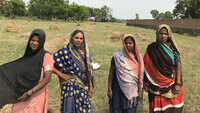
GUWAHATI: A change in the variety of rice being cultivated in the Sangte and Chugh valleys of Arunachal Pradesh has started pushing black-necked cranes, revered by Monpa Buddhists as an incarnation of the sixth Dalai Lama, away from their wintering sites.
The black-necked crane, which migrates from its breeding grounds in the Tibetan Plateau, has three wintering sites in India all of which are in Arunachal, including the Sangte and Chugh valleys in West Kameng district.
“The red rice would attract many insects because of the high sugar and zinc content and black-necked cranes would feed on them. Besides, because of wet cultivation, insects are not drawn to the fields after harvest,” said Dipayan Dey, chairperson of Kolkata-based South Asian Forum for Environment (SAFE) which has been conducting the study.
Of the 375 hectares under cultivation in the two valleys, red rice is grown in only 10-15% of the area with the rest used for Assam variety cultivation, Dey said. The reason is a shift from subsistence agriculture to commercial cultivation. “The change had started six to seven years ago, but was sped up since 2016-17 when the governm-ent started distributing 60kg rice to each family at Rs 2/kg”.
“When low-cost rice was made available, cultivation of the indigenous variety virtually stopped. It coincides with the time the cranes gave the valleys a complete miss,” he added. This year, three birds arrived in Sangte but only for a day. “They, all male pilot birds, are the first to arrive and the flock follows. Their stay determines if the flock will spend winter at a spot,” Dey added.
The black-necked crane, which migrates from its breeding grounds in the Tibetan Plateau, has three wintering sites in India all of which are in Arunachal, including the Sangte and Chugh valleys in West Kameng district.
The cranes stopped coming to the Sangte and Chugh valleys two years ago. This coincided with a switch from the indigenous red rice of japonica paddy strain to the “Assam variety” of indica paddy strain.
“The red rice would attract many insects because of the high sugar and zinc content and black-necked cranes would feed on them. Besides, because of wet cultivation, insects are not drawn to the fields after harvest,” said Dipayan Dey, chairperson of Kolkata-based South Asian Forum for Environment (SAFE) which has been conducting the study.
Of the 375 hectares under cultivation in the two valleys, red rice is grown in only 10-15% of the area with the rest used for Assam variety cultivation, Dey said. The reason is a shift from subsistence agriculture to commercial cultivation. “The change had started six to seven years ago, but was sped up since 2016-17 when the governm-ent started distributing 60kg rice to each family at Rs 2/kg”.
“When low-cost rice was made available, cultivation of the indigenous variety virtually stopped. It coincides with the time the cranes gave the valleys a complete miss,” he added. This year, three birds arrived in Sangte but only for a day. “They, all male pilot birds, are the first to arrive and the flock follows. Their stay determines if the flock will spend winter at a spot,” Dey added.
Download The Times of India News App for Latest India News.
#ElectionsWithTimes
more from times of india news
Elections 2019

Trending Topics
LATEST VIDEOS
More from TOI
Navbharat Times
Featured Today in Travel
Quick Links
Rajasthan election 2019Andhra Lok Sabha electionGujarat Election 2019Karnataka Election 2019MP Lok Sabha electionMaharashtra election 2019West Bengal Lok SabhaTamil Nadu election 2019UP Election 2019Bihar election 2019UP Election DateAndhra Election DateBihar Election DateAndhra Assembly ElectionLok SabhaMP Election DateMaharashtra Election DateShiv SenaYSRCPTDPWB Election DateJDUCongressBJP newsGujarat Election DateSC ST ActUIDAIIndian ArmyISRO newsSupreme CourtRajasthan Election DateTelangana Election DateTamilrockers 2018Uttarakhand newsSikkim newsOrrisa newsKarnataka Election DateNagaland newsSatta KingManipur newsMeghalaya news
Get the app










